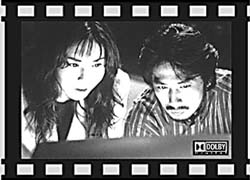Making Films and Scaring Audiences the Japanese Way

This year’s eighth Japanese film festival, sponsored by the Far East Society, is without doubt the most successful event of its kind in the industry. All previous years’ excursions into the Japanese cinema had often boiled down to featuring well-known names. This time, Kyiv audiences had a chance to learn about the new generation of Japanese genre filmmakers who for the past several years have been successfully conquering public hearts far from the land of the rising sun.
Motley productions by experimenting enthusiasts and numerous well-made entertaining movies that attract foreign audiences are indeed evidence of a steadily prospering national cinema. Elite and purely box office films complement each other; moreover, one cannot normally exist without the other. Pictures shown at the Zhovten Movie Theater in Kyiv served as the best illustration of this. All were entertaining, of course, yet one never felt like he had wasted his time after watching any of them, as each carried a message reaching above and beyond the limits of standard mass culture.
Shusuke Kaneko’s Gamera III: The Revenge of Iris is obviously meant for teenage audiences, a story about two monsters, Gamera and Gyaos, that mortally hate each other, their hatred climaxing in a breathtaking battle. The whole thing is more like a Christmas story, with two elements representing good (the mighty and clumsy Gamera) and evil (the formidable Gyaos embodying destructive human intellect). Of course, Western movie standards were noticeably present, as in Yuji Nakae’s Nabbie’s Love, a touching melodrama strongly influenced by Emir Kusturica’s colorful and boisterous production. Yet, even if and when borrowing, the Japanese come up with something of their own. The result is a European carnival incorporating the Japanese meditative quality, producing a most curious mix with all the elements amply present — passion, beautiful faces, music, and dances. Kioshi Kurosawa’s films reveal altogether different sources of influence, clearly distinct from those of his celebrated namesake. His drama License to Live is rather a thoughtful reflection about life and death, akin to our beloved Wim Wenders’ and Werner Herzog’s roadside movies. Today’s Japan, as seen by a boy after spending ten years in a coma, appears to be teeming with cranks and eccentrics.
After all, weird conduct and living on the verge of nonexistence could well be attributed to the Japanese cultural heritage; suffice it to remember the short horror stories popular in medieval Japan. Logically, Ring rose to the top of the festival’s list of ratings. This ascetic horror film made with jeweler’s precision has brought director Hideo Nakata kudos far beyond his homeland. It is a story about a video cassette killing the viewer using some demonic force. The picture is so frightening that some faint in the audience and certain scenes make everyone shriek, yet all eyes remain glued to the screen, because the director, unlike his US colleagues who excel in computerized special effects, grips the audience not with the sight of guts falling out or monsters, but with a masterfully created mystical atmosphere.
Add here a historical drama, a feature-length animated film, and several documentaries. The result is a rather voluminous panorama of latter-day Japanese cinema. Of course, the festival’s films far from exhaust the subject. There is no secret that Japan, like all the Far East tigers, is experiencing a real filmmaking boom. A more closer acquaintance with the Japanese cinematographic process would be a real gift to the Ukrainian film fans. Now, at least, the first step has been made in this direction.






